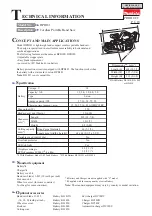
EN
83
4 POWER TOOL USE AND CARE
a)
Do not force the power tool. Use the cor-
rect power tool for your application.
The
correct power tool will do the job better and
safer at the rate for which it was designed.
b)
Do not use the power tool if the switch
does not turn it on and off.
Any power tool
that cannot be controlled with the switch is
dangerous and must be repaired.
c)
Disconnect the plug from the power
source and/or the battery pack from the
power tool before making any adjust-
ments, changing accessories, or storing
power tools.
Such preventive safety meas-
ures reduce the risk of starting the power
tool accidentally.
d)
Store idle power tools out of the reach
of children and do not allow persons
unfamiliar with the power tool or these
instructions to operate the power tool.
Power tools are dangerous in the hands of
untrained users.
e)
Maintain power tools. Check for mis-
alignment or binding of moving parts,
breakage of parts and any other condi-
tion that may affect the power tool’s op-
eration. If damaged, have the power tool
repaired before use.
Many accidents are
caused by poorly maintained power tools.
f)
Keep cutting tools sharp and clean.
Properly maintained cutting tools with sharp
cutting edges are less likely to bind and are
easier to control.
g)
Use the power tool, accessories and
tool bits etc. in accordance with these
instructions, taking into account the
working conditions and the work to be
performed.
Use of the power tool for op-
erations different from those intended could
result in a hazardous situation.
5 SERVICE
a)
Have your power tool serviced by a qual-
ified repair person using only identical
replacement parts.
This will ensure that
the safety of the power tool is maintained.
MACHINE SPECIFIC SAFETY WARNINGS
FOR PLUNGE SAWS
a)
DANGER: Keep hands away from
cutting area and the blade. Keep
your second hand on auxiliary handle, or
motor housing.
If both hands are holding
the saw, they cannot be cut by the blade.
b)
Do not reach underneath the workpiece.
The guard cannot protect you from the
blade below the workpiece.
c)
Adjust the cutting depth to the thickness
of the workpiece.
Less than a full tooth of
the blade teeth should be visible below the
workpiece.
d)
Never hold piece being cut in your hands
or across your leg. Secure the workpiece
to a stable platform.
It is important to sup-
port the work properly to minimize body ex-
posure, blade binding, or loss of control.
e)
Hold the power tool by insulated grip-
ping surfaces only, when performing an
operation where the cutting tool may
contact hidden wiring or its own cord.
Contact with a „live“ wire will also make ex-
posed metal parts of the power tool „live“
and could give the operator an electric
shock.
f)
When ripping, always use a rip fence or
straight edge guide.
This improves the
accuracy of cut and reduces the chance of
blade binding.
g)
Always use blades with correct size and
shape (diamond versus round) of arbour
holes.
Blades that do not match the mount-
ing hardware of the saw will run eccentri-
cally, causing loss of control.
h)
Never use damaged or incorrect blade
washers or bolt.
The blade washers and
bolt were specially designed for your saw,
for optimum performance and safety of op-
eration.
KICKBACK CAUSES AND RELATED WARN-
INGS
– Kickback is a sudden reaction to a pinched,
bound or misaligned saw blade, causing an
uncontrolled saw to lift up and out of the
workpiece toward the operator;
– when the blade is pinched or bound tightly








































